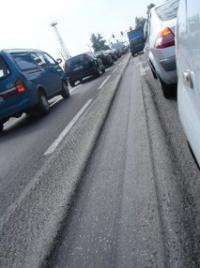Researcher using nanoclays to build better asphalt

Long before freeways and parking lots, a naturally occurring asphalt first appeared on roads in about 600 B.C. You can still see patches of it in the ancient city of Babylon.
Under the onslaught of 21st century traffic, modern asphalt isn’t likely to hold up for anywhere near 2,700 years. But at Michigan Technological University, Zhanping You is paving the way for brand-new asphalt blends to fight off cracks, rutting and potholes.
His work has drawn so much attention that one of his papers made SciVerse ScienceDirect’s Top 25 Hottest Articles of 2011 for the journal Construction and Building Materials.
“Nanoclay-Modified Asphalt Materials: Preparation and Characterization” reviews recent literature on asphalt that has been doctored with nanomaterials. It also presents new discoveries from You’s team suggesting that adding nanoclays to asphalt materials could make for safer, longer-lasting roadways.
“Asphalt is now made from petroleum, so it’s very expensive,” said You, an associate professor of civil and environmental engineering. “As a result, a lot of people are looking at ways to make it more durable.”
Heat, cold and stress in the form of traffic take their toll on asphalt pavement, made from a mix of asphalt and aggregates like gravel. That leads to cracks, potholes and a process called rutting. Ruts are most likely to form on busy roads, sections with slow traffic, and areas with stop signs and stoplights, where the rubber hits the road hard thousands of times a day.
“Rutting can be very dangerous, especially in snow and ice,” You said. “If we could use advanced materials to reduce rutting, that would be very beneficial to the public.”
You’s team tested two types of nanoclays, adding 2–4 percent by weight to the asphalt. That’s a smidgeon--less than half of a percent of the total weight of the asphalt pavement itself. But it made a big difference.
“It improved the viscosity significantly,” You said. “That means it will provide better stiffness, which means that it won’t deform as much in hot weather or under heavy traffic.”
They don’t yet know if nanoclay can help asphalt resist cracking in cold weather or under heavy loads, since their testing isn’t completed. “But it is always our goal to develop new asphalt mixtures with those qualities,” You said.
His lab is also testing how other nanomaterials, including nano-silica and nano-composites, will affect asphalt durability.
Provided by Michigan Technological University
















